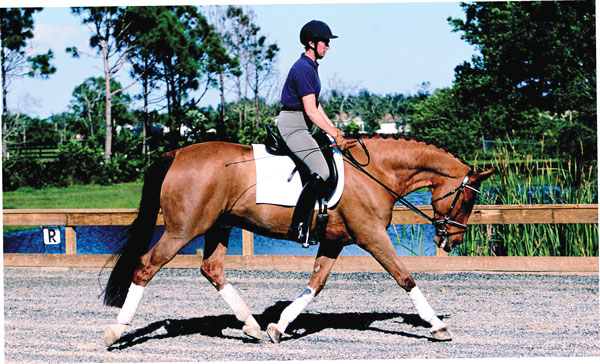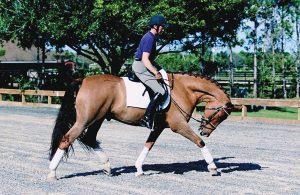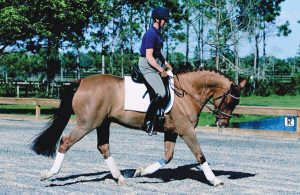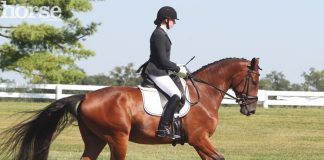
The most common mistake dressage riders make is to try to “put the horse together” by pulling on the reins instead of riding forward from the legs and seat into an elastic rein contact. This is also known as riding from “front to back” instead of “back to front.” As part of their effort to correct this bad habit, the experts who write the U.S. national dressage tests decided to include a movement called the stretching circle at Training and First Levels.
Stretching is Fundamental
Asking your horse to stretch his topline out and down and then gathering him back up again, all while maintaining an even tempo and contact, is an excellent test of his rhythm, suppleness, and acceptance of contact. The exercise reveals whether your horse is moving freely and willingly forward from your leg and seeking an elastic contact with the bit. If he is, then when you give the reins, the stretch happens naturally.
Even if you have no interest in showing, you should add the stretching circle to your training sessions. Here’s how.
Your Guide to Stretching
The U.S. Equestrian dressage test sheets spell out the “directive ideas” for the stretch circle dressage stretching circle. Listed in order of importance, they are:
◆ Forward and downward stretch over then back into a light contact, maintaining balancevand quality of trot;
◆ Bend;
◆ Shape and size of circle;
◆ Willing, clear transitions.
Notice that forward stretch is listed before downward stretch. If the horse reaches his neck down but not out, he’ll end up unbalanced and on his forehand instead of stretching over his entire topline and maintaining balance and engagement of his hindquarters.
A dressage horse stretching forward and downward is very different from, say, a western pleasure horse, who carries his neck low but without rein contact or lightness of the forehand. In addition, the dressage rules specify that the horse’s mouth should be about the height of the point of his shoulder—no lower—when he stretches. Imagine an invisible horizontal line between the shoulder and the mouth.
How do you get your horse to stretch correctly? Try this:
Start on a 20-meter circle in working trot rising. Find the tempo—you may have to experiment a little—in which your horse feels balanced, with his back swinging underneath your seat, neither poking along nor “running” and flattening onto his forehand.
Now, keeping the tempo of your posting the same, smoothly push both hands toward his mouth a few inches. As you give the rein, does your horse follow the contact with his head and neck? (He should.) That’s the beginning of a correct forward-downward stretch.
To go all the way into a stretching circle, simply allow the reins to lengthen gradually as your horse follows the contact out and down. Maintain that stretched outline until you’re a few strides away from completing the circle.
Gradually take up the reins while your legs and posting tempo maintain the forward energy and desired trot rhythm. By the time you’re back where you started, your horse should have returned to his normal working-trot outline, with your reins shortened to their usual length.
A Training Self-Test
You can use the stretch circle dressage stretching circle to help evaluate the correctness of your basic training.
Try these troubleshooting tips if your horse does any of the following.
◆ Raises His Neck and Head and Hollows His Back: He was not truly on the bit and accepting the contact; you were using too much hand to hold him in a “frame;” or both. Or, he possibly has pain in his mouth, teeth, or head.
Fix It: If he hasn’t had a dental checkup recently, get his mouth and teeth (and bridle and bit fit) evaluated and any issues corrected. Then go back to basics: lots of transitions between and within gaits; correct longeing with side reins to teach him to go forward into an elastic contact (get a pro’s help if you don’t know proper longeing and safety techniques); and take lessons doing equitation work to learn to ride without relying on the reins for balance.
◆ Dives Down in Front but Doesn’t Stretch Forward: The rein contact may be restricting his ability to reach out with his neck and head. Suddenly dropping the contact can cause a loss of balance. Insufficient energy may also result in a stretch that goes down but not out.
Fix It: Make sure you lengthen the reins sufficiently to allow your horse to stretch forward and downward. Maintain an elastic contact instead of “throwing the reins at him.” Ensure that you establish and maintain a nicely forward working trot with good push from behind. A “dinky trot” doesn’t have enough energy to produce good stretch.

◆ Stretches Out and Down, Then Curls Behind the Vertical: The rein contact may be too strong or restrictive. Or he may be avoiding the contact altogether. Or, as with the horse that flips his head or goes above the bit, he may have pain in his mouth or elsewhere.
Fix It: Check for and correct any dental or equipment-related issues. Next, lighten your hands and lengthen the reins if needed.
If he’s curling and there’s no weight in the reins at all, this is a tougher fix, especially if he habitually ducks behind the vertical. The horse that “hides” behind the bit and won’t reach into the contact requires slow, patient re-education with sensitive hands, well-timed aids and half-halts, and sometimes a milder bit. Help from a reputable dressage trainer might be in order here
◆ Speeds Up Instead of Stretching When You Give the Reins: You’ve probably been using your hands, instead of your legs and seat, to regulate his tempo.

Fix It: Post in the tempo you want your horse to follow, instead of adjusting your tempo according to the speed he offers.
The horse that wants to quicken has to learn that the rider sets the tempo—a lesson imparted through a zillion turns, circles, changes of direction, and transitions between and within gaits. Bending lines are better than straight lines for slowing and balancing the horse and for giving the rider control.
Incorporate Into Daily Work
Many horses benefit from correct stretching during warmup. Or after a more demanding exercise, a short stretch will relax your horse’s muscles. Ending your training sessions with a few stretching-trot circles will also loosen his muscles as you begin the cooling-out process.
Photos reprinted from The USDF Guide to Dressage, available from Storey Publishing, storey.com
This article about stretch circle dressage appeared in the May 2020 issue of Horse Illustrated magazine. Click here to subscribe!





